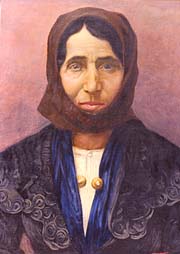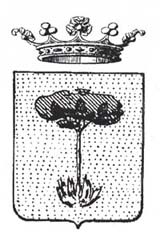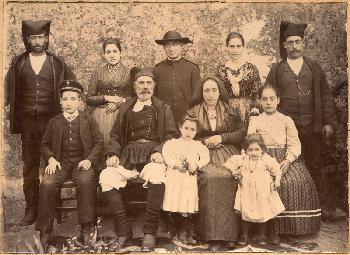| 16 | The Satta-Bacciu Story |
The
Satta-Bacciu Family
One
oft told interpretation of the origin of the name Satta is that originally
it was "S'atta", which means "the knife's edge",
perhaps derived from the pirates coming from Northern Europe. This would
also explain the above average height of the Sattas and their fair
complexion and clear eyes.
Some
connection does exist in Sardinia with the far North, as is evidenced in the
Sardinian dance, called "Scottis", which is similar to the
Scottish jig and identical to a local dance seen in Bergen in Norway.
Perhaps the Vikings did manage to sail this far South at some time in
history.

Anastasia Altana married a Bacciu and gave birth to Giovanni Battista, who was to become a priest, and affectionately known as "Babbai", and to Giovanna Anna. This daughter subsequently married another Bacciu, Giovanni and had four daughters, Maria, Giovanna, Teresa and Giacobba, the latter marrying Giovanni Satta, from Ozieri.
An
haraldic search on the name Satta, gave the following result: "A
Gallura family (Gallura is the North-Eastern part of Sardinia) whose
origins date from the early 16th century. In 1502 a certain Angelo Satta
obtained the jurisdiction of the podestÓ over the Coghinas area, from
Count d'Oliva, which his descedndants
kept until 1596. One of these, Antonio, in 1599 obtained a
knight-hood; his sons were admitted to the military ......... in 1626
during the Vivas parliament and thereafter were permitted to attend other
parliamentary sittings. The sons of Antonio formed two separate branches
of the family:
a) Giovanni Antonio continued to live in Tempio and had two
sons, who formed two other branches; Giovanni Battista continued the Satta
line in Tempio, which died out in the 18th century; Giovanni Antonio
settled in Nulvi where his descendants continued to live.

 The Satta coat of arms
The Satta coat of arms
b)
From Giovanni Maria, the other son of Antonio, descended a branch which
divided further in the course of the centuries. His son Francesco lived in
Bitti and in 1642 obtained a hereditary knight-hood and nobility in 1646
and was also accepted to military ........... His sons gave origin to
three different lines: from Peter, who lived in Buddus˛, descended the
Sattas of Pattada and of Bonorva, who received a further acknowledgment of
nobility in 1777, together with the brothers Antonio Michele, a priest,
Giuseppe Pietro and their nephew Philip. From Francesco descended the
Satta Apeludi of Bitti, one section of which transferred to Mamoida and
Gavoi, in the 18th century."
 The
Bacciu family - Click to enlarge
The
Bacciu family - Click to enlarge
Giovanni
Satta was born in Tula, direct and only decendant of the wealthy
landowning family Chessa and by profession was a high-school teacher. He
married a girl from Buddus˛, Giacobba Bacciu in 1938 and went to live on
the mainland. They lived in their own house in Frascati, a pretty town
overlooking Rome, situated on the slope of an old volcano and is famous
for its light white wine. Giovanni taught in two schools
in Rome for the sons of the Italian nobility, Nobile Collegio
Mondragone and Villa Sora and has had some very illustrious pupils.

During
the war, the Germans made the princely Villa Aldobrandini their
headquarters, which came under fire by the American allies, trying to rout
them from Italy. It was on one of these airial bombing raids, on the 8th
of September 1943, that Giacobba sought shelter, together with the other
inhabitants of Frascati, in the large wine cellars, 42 steps deep beneath
the villa. She was 8 months pregnant of Margherita and held the 14 month
old Anna in her arms, who shuddered at each bomb blast.
When
it was all over, she came out to find that the whole town was razed to the
ground. Her nine room house had been abundantly furnished with antique
family heirlooms and the cellar was stacked with still unopened wedding
gifts and with large stocks of olive oil. An incendiary bomb had centred
the house, destroying it and the resulting fire raged for days. The iron
bedsteads, the silvery cutlery and jewellery, were fused into a single
mass of metal. There was nothing to be saved; they had lost everything.
Today there is a small piazza near the church to mark the empty place
where the house once stood.
Giovanni
was in Rome that day and witnessed the bombing from afar. He rushed to
Frascati fearing the worst and found his wife and child in a state of
shock, but alive. Sadly, they made their way back to Rome. Here they
rented an apartment that had belonged to the Jewish engineer Bernabei, who
had been an innocent victim of the Nazis. He was one of the 120 persons
that had been picked at random, rushed off to the Ardeatine caves and
machined-gunned, in retaliation for the 12 German soldiers killed in a
partisan bomb blast in Via Rasella, in Rome.
You can still see today the deflagration marks on the walls of the
houses there and the Fosse delle Ardeatine have become a national monument.
While
living in this house, they had an inspection by the Nazis and Giovanni was
terrified for his wife Giacobba, who had Jewish sounding name, being the
feminine of "Jacob". He feared that she be whisked off to a
concentration camp, as happened to many Italian Jews in that period.
Giacobba took care to always give her name as "Giacomina", which
remained all her life.
Return to Menu of Camillo Story
l-camillo.com
Copyright L. Camillo 2000
